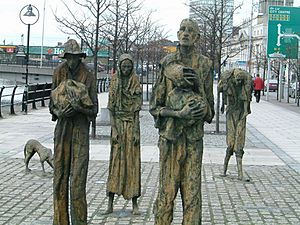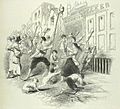Irish Potato Famine facts for kids
Quick facts for kids Great Faminean Gorta Mór |
|
|---|---|

Scene at Skibbereen during the Great Famine, by Cork artist James Mahony (1810–1879), commissioned by The Illustrated London News, 1847.
|
|
| Country | United Kingdom of Great Britain and Ireland |
| Location | Ireland |
| Period | 1845–1852 |
| Total deaths | 1 million |
| Observations | Policy failure, potato blight, Corn Laws |
| Relief | see below |
| Impact on demographics | Population fell by 20–25% due to mortality and emigration |
| Consequences | Permanent change in the country's demographic, political and cultural landscape |
| Website | See List of memorials to the Great Famine |
| Preceded by | Irish Famine (1740–41) (Bliain an Áir) |
| Succeeded by | Irish Famine, 1879 (An Gorta Beag) |
The Great Famine, also known as the Great Hunger (Irish: an Gorta Mór), was a terrible time in Ireland. It was a period of widespread starvation that lasted from 1845 to 1852. Before the famine, Ireland had about 8.5 million people. By 1901, this number had dropped to just 4.4 million.
During the Great Hunger, about 1 million people died. More than 1 million others left the country to find a better life. This caused Ireland's population to shrink by 20–25% between 1841 and 1871. In some towns, the population fell by as much as 67%. Between 1845 and 1855, over 2.1 million people left Ireland. They mostly traveled on packet ships, steamboats, and barques. This was one of the largest movements of people from a single island in history.
For both the people living in Ireland and those who moved away, the famine became a very important part of their history and stories.
Contents
What Caused the Great Famine?
The main cause of the famine was a plant disease called blight. This disease infected potato crops all over Europe in the 1840s. Experts are still not sure exactly how or when blight first arrived in Europe. It probably appeared around 1844. This disease came from the Toluca Valley in Mexico. From there, it spread across North America and then to Europe. By August 1845, it had reached many parts of northern and central Europe. Countries like Belgium, the Netherlands, northern France, and southern England were already affected.
In 1846, three-quarters of Ireland's potato harvest was destroyed by the blight. In 1847, there were very few potatoes left to plant for the next year. Even though the crops that did grow had average yields, hunger continued. The 1848 potato harvest was only two-thirds of what was normal. Over three million Irish people depended completely on potatoes for their food. Because of this, hunger and famine became widespread.
The historian Cecil Woodham-Smith wrote that many people were angry about one fact. Huge amounts of food were sent from Ireland to England. This happened even while people in Ireland were dying of starvation.
How Many People Died?
We don't know the exact number of people who died during the famine. It is believed that more people died from diseases than from actual starvation. At that time, there were no official records of births, marriages, or deaths. Records kept by the Catholic Church are also not complete.
A census in 1841 showed Ireland had 8,175,124 people. A census taken right after the famine in 1851 counted 6,552,385 people. This was a drop of over 1.5 million people in just 10 years. Experts believe that if the famine had not happened, the population in 1851 would have grown to over 9 million.
Most deaths were not from a lack of food directly. They were from illnesses that happened because people were so weak from hunger. People who don't get enough food are very likely to get sick. Diseases like Measles, diphtheria, diarrhoea, tuberculosis, and many respiratory infections became much more serious. Whooping cough, many intestinal parasites, and cholera were also made worse by poor nutrition.
Diseases like smallpox and influenza were so strong that they spread no matter how healthy people were. Fever was the biggest killer. People at the time, and doctors, believed that fever and famine were closely linked. People gathering together in large groups also helped diseases spread. The hungry gathered at soup kitchens, food depots, and crowded workhouses. These places were perfect for spreading infectious diseases like typhus, typhoid, and relapsing fever.
Remembering the Famine
Ireland has a National Famine Memorial. It is in Murrisk Millennium Peace Park. This park is five acres and looks out over the Atlantic Ocean. It is in the village of Murrisk, County Mayo, at the foot of Croagh Patrick mountain.
National Famine Commemoration Day is held every year in Ireland. It usually takes place on a Sunday in May.
The famine is also remembered in many places across Ireland. This is especially true in areas that suffered the most. It is also remembered in other countries, particularly in cities with many people whose families came from Ireland. For example, the Irish Hunger Memorial is near the Manhattan waterfront in New York City.
A large sculpture called Kindred Spirits was put up in 2017. It is made of stainless steel and shows nine eagle feathers. It is in the Irish town of Midleton, County Cork. This sculpture thanks the Choctaw people for their financial help during the famine.
An annual Great Famine walk takes place from Doolough to Louisburgh, County Mayo. It started in 1988. Important people like Archbishop Desmond Tutu of South Africa and representatives from the Choctaw nation have led the walk. The walk is organized by Afri. It happens on the first or second Saturday of May. It connects the memory of the famine with today's human rights issues.
Images for kids
-
A potato infected with late blight, showing typical rot symptoms
-
A starving Irish family from Carraroe, County Galway, during the Great Famine (National Library of Ireland)
-
Scene at the gate of the workhouse, c. 1846
-
Lord Palmerston, then British Foreign Secretary, evicted some 2,000 of his tenants.
-
The Emigrants' Farewell, engraving by Henry Doyle (1827–1893), from Mary Frances Cusack's Illustrated History of Ireland, 1868
See also
 In Spanish: Gran hambruna irlandesa para niños
In Spanish: Gran hambruna irlandesa para niños














